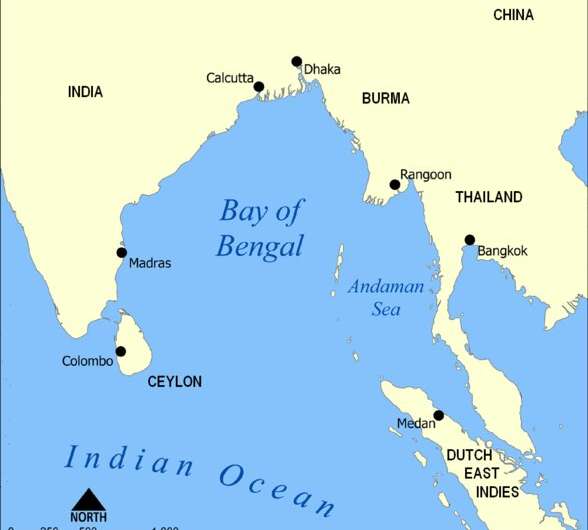This article has been reviewed according to Science X's editorial process and policies. Editors have highlighted the following attributes while ensuring the content's credibility:
fact-checked
trusted source
proofread
Enhanced weathering input from South Asia to the Indian Ocean since the late Eocene

Researchers led by Prof. Wan Shiming from the Institute of Oceanology of the Chinese Academy of Sciences (IOCAS) and their collaborators reported a continuous weathering record spanning the past 37 million years, which was based on planktonic foraminiferal neodymium isotopes (εNd) of marine sediment core in the Bay of Bengal (BoB).
The study was published in Science Bulletin on Jan. 13.
Seawater εNd distribution in the northern Indian Ocean displays an obvious north-south gradient in the BoB, which is induced by different Nd isotopic characteristics of the terrigenous input from the Himalayan river systems and water masses mixing from the Southern Ocean. This suggests a two end-member mixing by the South Asian continental weathering input and the Indian Ocean deep water mass.
The researchers reported the radiogenic Nd isotope record of planktonic foraminifera of Ocean Drilling Program (ODP) Site 758 sediments in the northern Indian Ocean since the late Eocene, and compared it with the Nd isotope record in the central Indian Ocean to eliminate the influence of the Indian Ocean water masses.
They proposed a new proxy, ΔεNd, the difference between these two parts, to indicate the contribution of continental weathering from South Asia to the Indian Ocean.
The εNd values of the foraminifera at ODP Site 758 showed a long-term negative trend, and a distinct variation relative to detrital Nd isotopes and the clay mineral ratio of smectite/(illite + chlorite) at the same core, but similar rapid pulses occurred with increasing terrigenous flux at ~21, 8, 6 Ma and since 3 Ma. This observation indicated that the foraminiferal Nd isotope record at Site 758 might not be significantly influenced by changes in sediment provenance and weathering degree onshore, but mainly reflected the evolution of silicate weathering input from South Asia.
"The ΔεNd suggests a long-term intensification of South Asian weathering input since the late Cenozoic," said Prof. Wan.
Specifically, the growth of ΔεNd values during 25–13 Ma and 5–0 Ma corresponded to the rapid uplift of the Himalayan orogeny during the late Miocene and Pliocene, fast exhumation at Himalayan syntaxes and outward growth in eastern Tibet during the early Pliocene, as well as global cooling since the early Pliocene. This indicates a coupled tectonic-climate-weathering evolution in South Asia.
Moreover, the atmospheric CO2 level showed a rapid decline during the enhanced South Asian weathering input periods. This is also supported by the consistent variations in ΔεNd with the long-term evolution of Li and Sr isotopes in seawater since the late Eocene.
"Our study provides the first evidence of long-term enhanced weathering input obtained from seawater Nd isotope in South Asia since the late Eocene. This suggests that the intensification of silicate weathering caused by the uplift of the Himalayas plays an important role in the global cooling at the late Cenozoic," said Song Zehua, first author of the study.
"We'll combine simulations to accurately quantify the carbon sink effect of South Asian weathering on the late Cenozoic cooling in future studies," said Prof. Wan.
More information: Zehua Song et al, Enhanced weathering input from South Asia to the Indian Ocean since the late Eocene, Science Bulletin (2023). DOI: 10.1016/j.scib.2023.01.015
Provided by Chinese Academy of Sciences





















